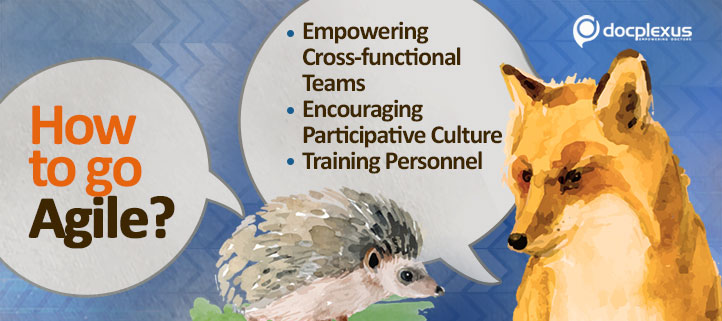
Traditionally, pharma marketers choose to be Hedgehogs- long term planning, lengthy deliberations, no provisions for mid-term course corrections. At the same time, counterparts in other sectors are turning into Foxes- swift and on-point, converting every opportunity into a success story by implementing Agile. Is it the right fit for a highly-regulated sector like Pharma though? If yes, how to attain it?
Rooted in IT, Agile is offering organisations enhanced marketing opportunities. Based on responding rapidly to both market events and the needs of stakeholders using data and analytics, the methodology is aiding companies in reducing operations cost by allowing prompt course correction and enabling swift decision making, thereby increasing efficiency.
Therefore, it is not surprising at all that the rate of hopping on-board the Agile wagon is at all-time high for marketers across industry verticals (even though it is quite low for Pharma). A survey by PMI revealed that 71% companies from the sample were Agile and there is good reason- translates into 28% more success than traditional method. Consultant firm McKinsey states that a high-functioning Agile set-up operating at scale can have multiple campaigns running together and generates multiple ideas every week!
Well then, what is stopping pharma marketers from going Agile?
Barriers to Agile Pharma Marketing and How to Overcome Them
Traditional mindset: It is hard transitioning from a command-and-control set-up to a creative, iterative and more experimental structure- turning into Foxes from Hedgehogs. In marketing, Hedgehogs are in a habit of planning long term- 6 months to 1 year – and then sitting towards the end with the entire team evaluating performance, lags/blunders, if any. The problem of such planning is that by the time we figure out flaws and fixes, we are already too late in the day, pushed to the borders of irrelevance and because the industry is competitive, delays are unadvizable.
Take for instance, planning of visual aids and communications strategy, which is prepared at one go after following a long process of creation and approvals and is therefore identical for a vast audience, notwithstanding their varying requirements. Once finalized, it leaves marketers with hardly any space to improvise when they realize that material is out of sync with what the audience wants. These are opportunities lost forever. Very high price to pay. This is one front where Agile Foxes score higher than Traditional Hedgehogs because they’d be able to customize the strategy as per the requirement.
What can be done? Historically, traditional methods have worked just fine for Pharma and leaving the warmth of that tested and proven approach isn’t exactly comforting. But, with doctor and patient behavior undergoing a dramatic shift, acknowledging need to revisit the viewpoint is required-knowing what has become redundant and is a drain on resources for enhanced marketing function – processes instead of people, as soon as possible.
Another thing required is acknowledging that digital has changed the ball-game for pharma marketers, opening avenue like never before-better understanding of audience, its needs and how to plug the gaps.
Audience demands swift action/redressal. It needs precision in offerings. From the example above, imagine how inch-perfect it would be if you know in advance the precise requirements and preferences of a doctor before actually visiting him.
Agile facilitates this sort of approach because it leverages technology. It also adds on to it through its bite-sized decision-making, paving way for more dynamism. You do not have to wait till it’s too late. Problem areas can be addressed immediately, thanks to constant monitoring. Key is empowering smaller, cross-functional teams, even across organisations if that translates to better-decision making.
Multiple approvals: There is no point creating a war room or launch room (Agile terminology; team of people with varied skills, able enough to complete a task by themselves) if pharma companies’ huge marketing departments, requiring multiple sign-off layers, would ultimately bog down the process. Besides, we are all aware how in every organisation, employees in authority nip innovative ideas in the bud because they look risky. The fear is understandable. They are responsible and the huge expenditure in R&D makes even the bravest tremble.
What can be done? A more open culture (as opposed to authoritative style) in which employees at the lower levels are empowered to take decisions is the right step ahead. Agile makes that possible. It allows us to be responsive to any event that might happen at any stage of the process.
The team has flexibility and authority to prioritize tasks and meet goals as and when required, based on constant evolution in data and feedback. What is needed is smaller teams (about 5-6 participants) with members having varied expertise, decision makers included.
To understand why a member from medical affairs could be required in a marketing team, let’s study a hypothetical situation. Take an example, when Medical Affairs Executives present new scientific developments at a conference, the team may receive real-time alerts, making it a critical data-point. If it does not review it promptly, that data is wasted. Medical Affairs is not just about managing the regulatory compliance but also about enabling dissemination of crucial intelligence for marketing and other departments to make use of it at the earliest. Other than that, a quick clearance from Medical Affairs to any marketing initiative is highly helpful in launching them at the right time.
(Read about the evolving role of Medical Affairs here)
Regulatory bottlenecks– The sector is heavily regulated and operates in the shadow of uncertainty, so compliance is cumbersome but important. Therefore, finding a way around signing-off delays is the need of the hour.
What can be done? Agile provides the ideal solution. When you decentralize authority and train people for such configuration, effective and swift and impactful decision-making becomes a natural outcome. Technology, which is an every-day part of the process, further makes your work efficient and more visible. For instance, usage of Kanban boards aids regulation and can act as guidelines if used properly, freeing the C-suite and higher officials from the cumbersome task of combing through decisions every step of the way.

Takeaways for pharma?
Start small but start nonetheless: Go slow and take one step at a time but take it already. Turn one project Agile. Measure impact and efficiency accrued. For Astra Zeneca when it embraced the methodology in 2014, reduction in cost was 25-40%. So, it made sense for them to embrace it fully and for long-term.
Note that initially, your approach should be: One project Agile. Evaluate. Replicate. Not everything works for everybody. It is all about understanding what suits your business needs. Every step matters and learning from each mistake or success, big or small, forms the core Agile principle.
Look for tech partners who can facilitate agility: You are developing a drug, or have developed one. Now you want to understand how the market takes it, doctors see it and if they would ever prescribe it over a similar product already available. There are few things you can do. You can visit a clinic or hospital, struggle gaining a doctor’s attention and see if that interaction provides this very crucial data. Around 80% doctors don’t want to have a face-to-face interaction with a pharma marketer and the rest give less than 10 mins to him. You can also use digital platforms such as Docplexus that allow doctors the access to such information, and interact then and there.
Besides, our project execution team plans out the right communications strategy through mindset analysis, co-creating content for your marketing goals, monitoring real time changes to communication and messaging, providing you with analytics and updates regularly so you are ahead of the game every step of the way.
Patty Sheehan, Astra Zeneca’s Agile Cultural Change Lead and Coach sums up the Agility outcome for the company as, “We’re delivering faster with greater quality and less manpower—resulting in substantial financial benefits from the teams that have adopted Agile to date. We expect to double our adoption of Agile this year.”
So, is Agile marketing for pharma? With the target audience as volatile as it is, it is the way forward. Is it a panacea, though? A lot depends on an organisation’s willingness and actual efforts to turn marketing force into Foxes.
